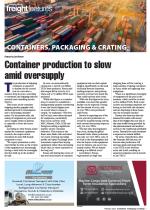The production of shipping containers is expected to decline for the second year in a row after a massive drop in 2022, according to maritime and shipping industry research and consulting service Drew r y.This comes as the container shipping market grapples with subdued growth in consumption due to increasing consumer prices. On the positive side, the easing of congestion at ports and across supply chains in general is expected to boost the sector slightly.According to John Fossey, senior analyst for container equipment research, the output of new containers in 2022 fell sharply compared to 2021.“We expect production to slow even further in 2023 as the owners of the equipment are increasingly having to deal with the oversupply that has built up in the market,” he said.In 2021, an extraordinarily strong year, a record 7.13 million TEUs were produced. Fossey said this output fell in 2022 by 47% when only 3.77 million TEUs were produced.“While this figure is a massive drop, it cannot be considered a disappointing number considering it was the fourth-highest year on record when it comes to output,” he explained. “The first half of 2022 saw robust demand for equipment, particularly from ocean carriers, with MSC, Maersk, CMA CGM and Evergreen taking a significant number of new container deliveries. This comes as the liners were f lush with cash after two years of strong operating profits and opted to plough more investment capital into buying equipment rather than increasing leases that are more expensive in the long run.”Fossey said during the course of last year most leasers of container equipment had cut their capital budgets significantly on the back of already forecast uncertain trading prospects, and growing concerns over just how much the f leet could increase since 2020.“With the first figures for 2023 available, it is clear that another decline can be expected. During the first month of 2023, only 53 000 TEUs were produced,” said Fossey.Drewry is expecting one of the worst years for production on record for manufacturing activity, with current forecasting output at only 700 000 TEUs.“The last time that happened was 2009, during the global financial crisis, when production was only 407 000 TEUs. Also, if we look at the demographics and who the buyers of the equipment were in January, one sees it was mainly traders. We are indeed looking at a difficult 2023.”According to Fossey, expectations are high that shipping lines will be retiring a large number of ageing containers in 2023, while not replacing that equipment.“There is a significant oversupply of equipment in the pool at the moment, which could be as much as five million TEUs. Both ocean carriers and leasing companies are having to deal with this situation and are disposing of these boxes into the secondary market.”Drewry also forecasts that the demand for reefers will exceed that of dry freight this year due to the extra traffic being provided by the pharmaceutical and medical sectors to the traditional perishable sector. Demand for tank containers is expected to remain bullish.“In terms of production, after the dramatic fall this year, we forecast that production will increase again and range from 4-5m TEUs a year between 2024 and 2026, totalling an expected container pool of around 55.1m TEUs.”

